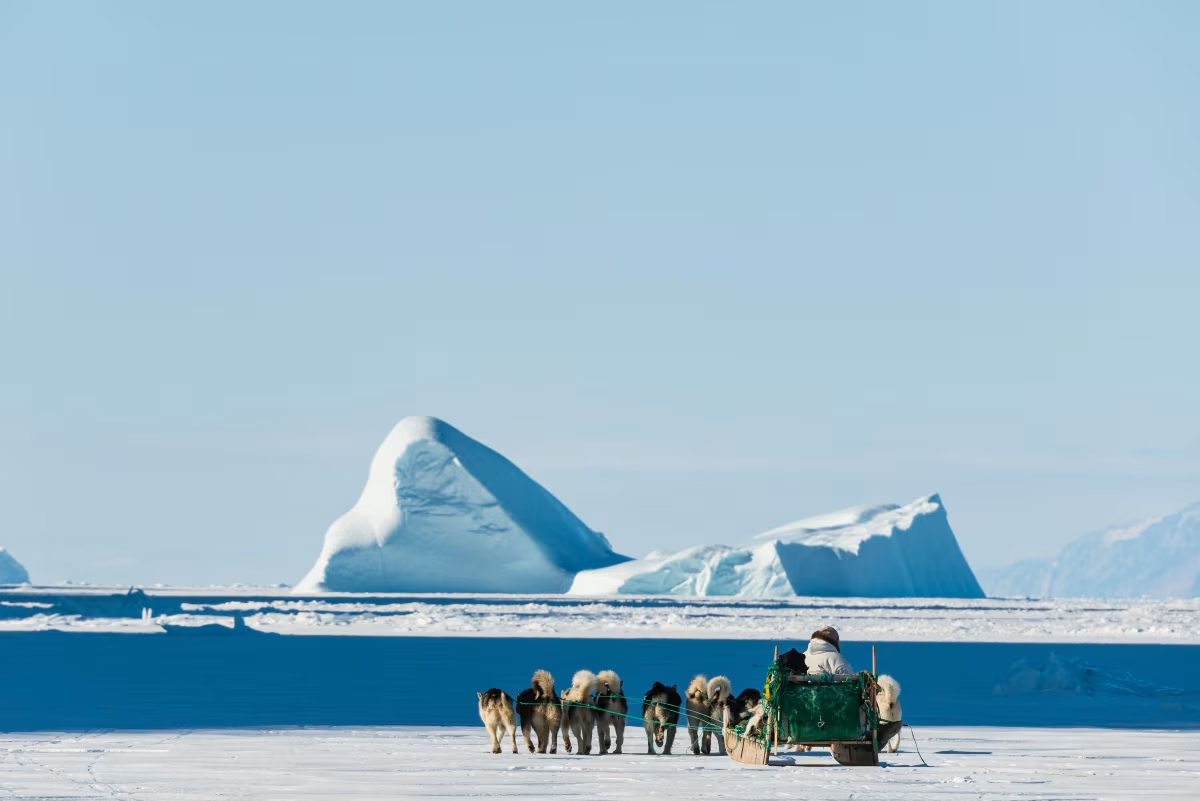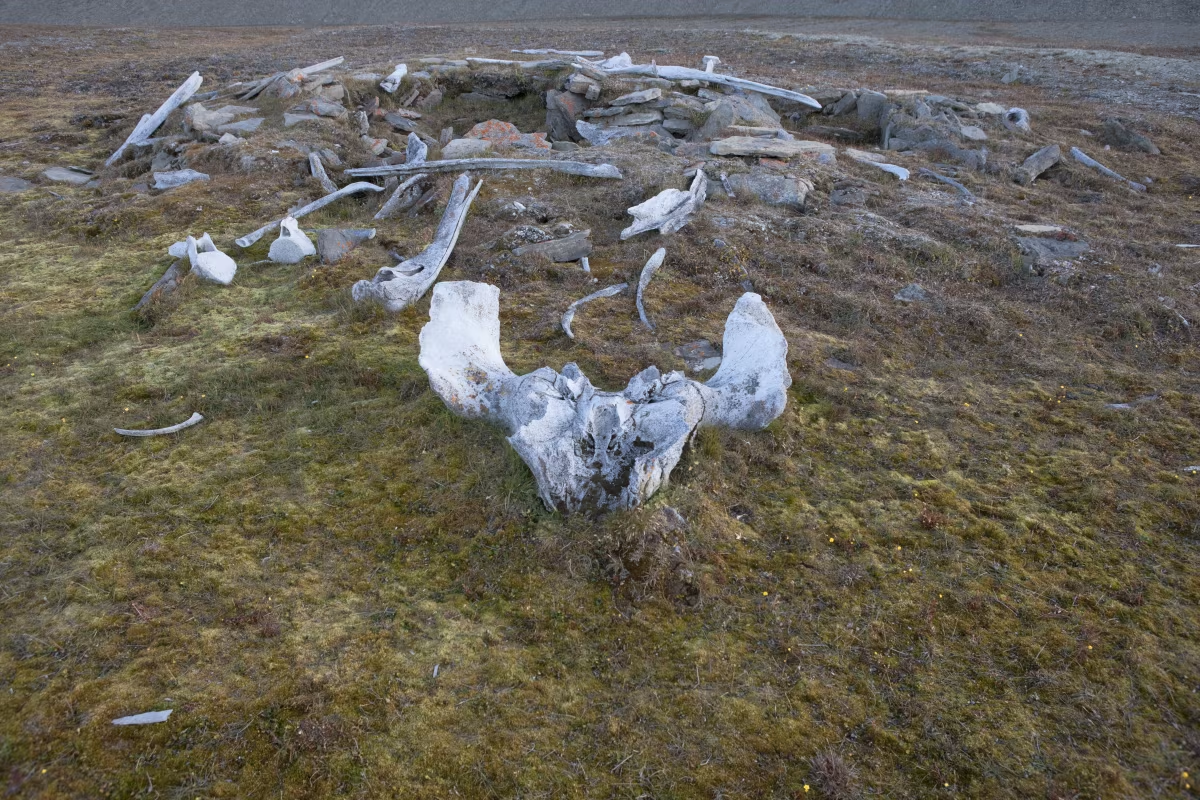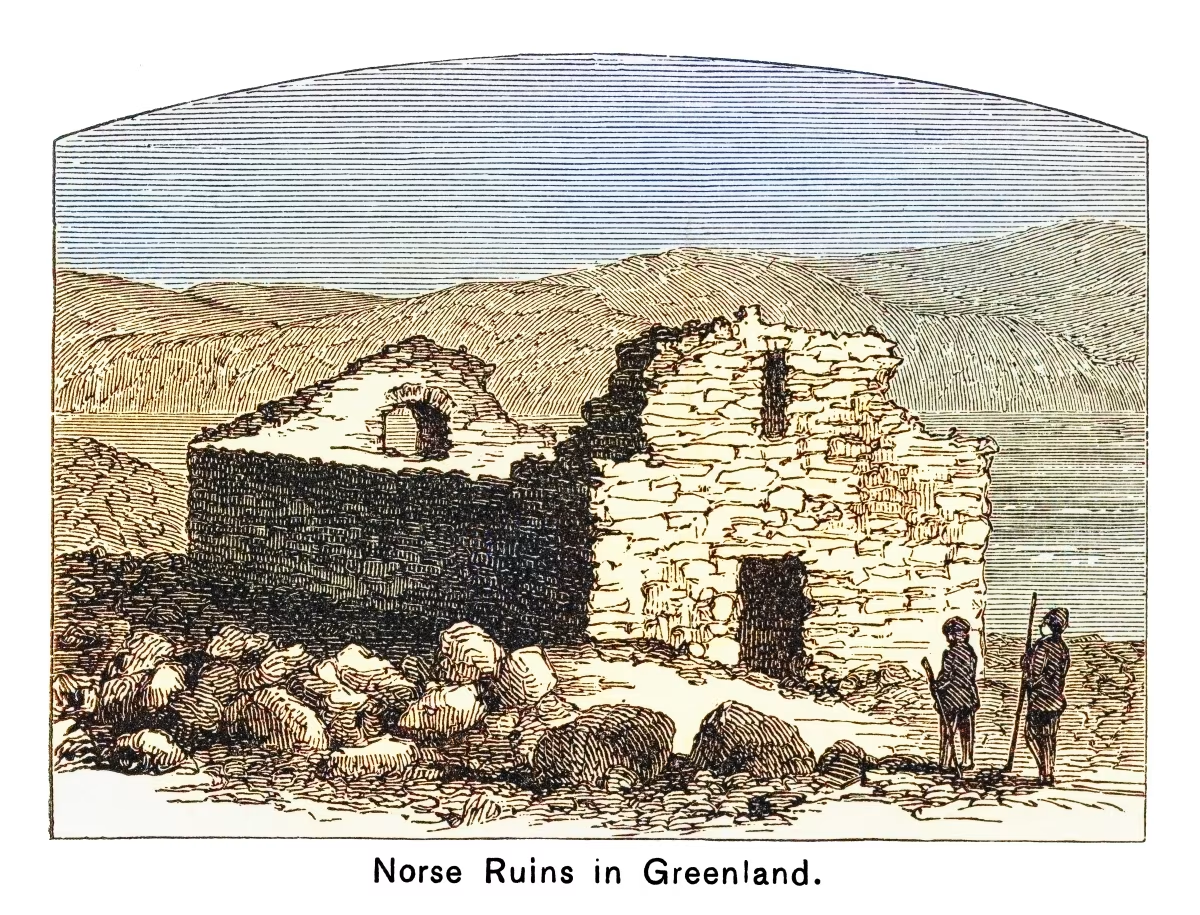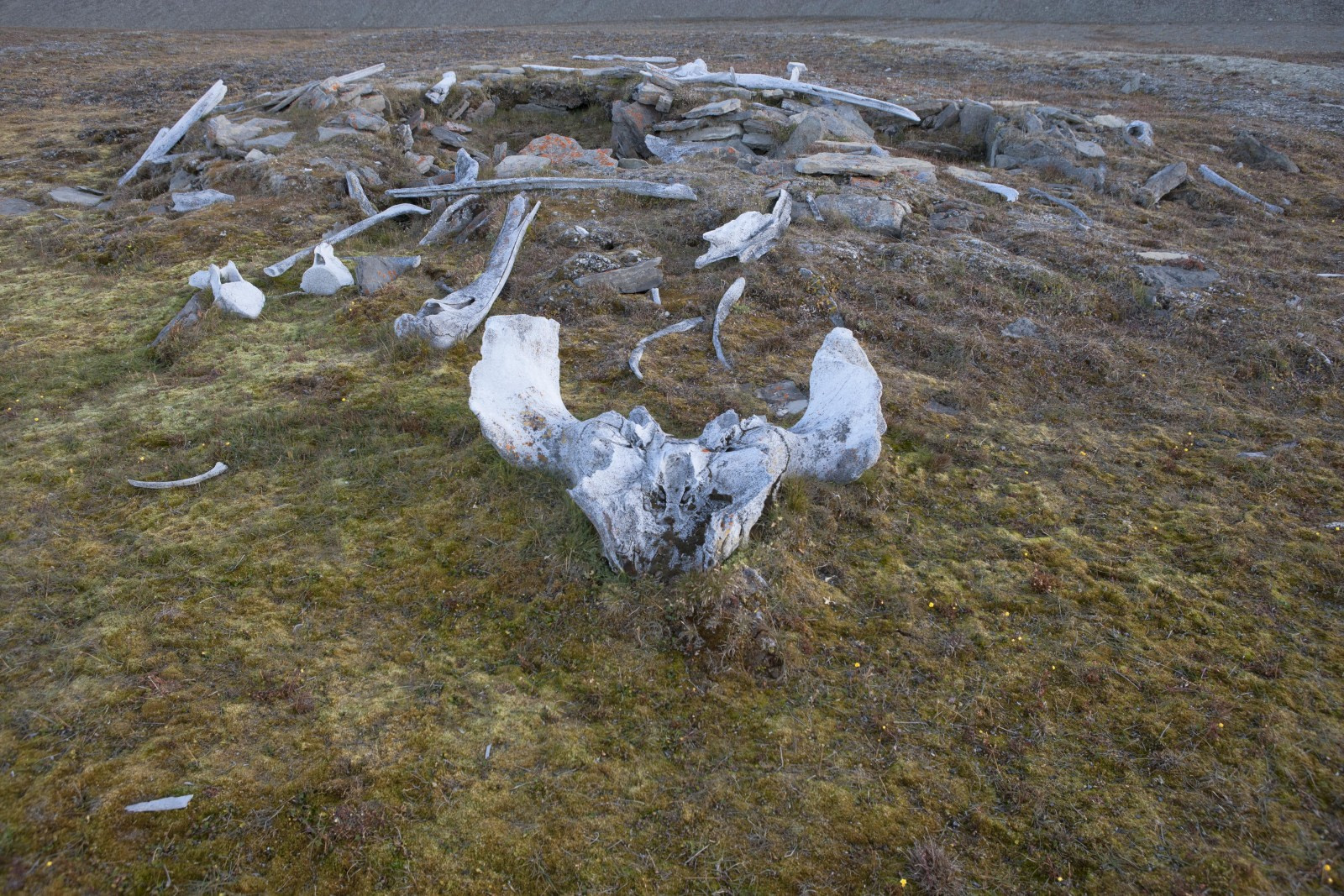Greenland is rightly known for its stunning landscapes. It's an ancient, dramatic world of spiralling, jagged peaks, immense walls of ice, and staggeringly vast, carved fjords that offer tantalizing glimpses of an icy, inhospitable interior. But, along with its visual splendor, Greenland also has a rich human history, often overlooked by visitors!
The mysterious Thule culture has left its mark on this wild, beautiful land, and its presence continues to be felt through the oral traditions and culture of its modern-day descendants, the Greenlandic Inuit.
Greenland - a land of change and human survival
Today, the Greenlandic Inuit are recognized as the indigenous people of Greenland, representing around 90% of the country's population. However, like other parts of the world, Greenland has seen shifts in population and culture over its inhabited history, which is believed to span approximately 4,500 years.

Photo: A team of sled dogs pulls a sled over a vast icy expanse in Greenland, with large icebergs rising in the clear blue background under bright dayligh | Getty Images
The earliest known culture to have inhabited Greenland was the Saqqaq people, who are known to have lived in Southern Greenland from around 2500 BCE. The Saqqaq culture also coexisted with the Independence I culture, another group that inhabited the north of Greenland until around 1900 BCE, but whether sustained interaction between these two groups occurred is unknown. After the disappearance of Independence I, the Independence II culture emerged, with evidence of its presence in northern Greenland dating back to 80 BCE.
By the early modern era, another group had expanded across the Canadian Arctic and into Greenland, the Dorset Culture. Evidence of their presence exists across the Arctic between 500 BCE and 1350 CE. The Dorset, Saqqaq, and Independence cultures are collectively referred to as 'Paleo-Eskimo' cultures, now often classified as either pre-Thule or pre-Inuit cultures. These groups are understood to be genetically distinct from the later Thule culture and modern Inuit. The Dorset culture was the final group of these pre-Inuit cultures to thrive in the Arctic, their presence dwindling as the contemporary era approached.
Coinciding with the gradual decline of the Dorset culture was the expansion of the Thule culture across the eastern Canadian Arctic and into Greenland, emerging around 900 CE in Alaska. By 1350 CE, the Dorset had almost entirely vanished, and the Thule people had firmly established themselves as the indigenous population of the High Arctic, including much of the coastline of Greenland. Thule remains have been found along much of the western, southern, and eastern shores of Greenland, as well as much of the Canadian High Arctic.
Who were the Thule people?
The little we know of the Thule people is a result of both archaeological evidence and oral traditions passed down through generations. Distinct from other Arctic peoples, they built semi-subterranean houses, perfect for permanent winter camps. They also migrated extensively, with interlinked communities spread across the Canadian Arctic and Greenland. It is believed that the Thule descended from the Birnik culture of the Chukchi Peninsula in Siberia, who crossed the Bering Strait into Alaska. The Thule migrated steadily eastward, replacing earlier pre-Inuit cultures as they expanded.

Photo: Ruin of an ancient Thule house that had been constructed with whalebone, in the Canadian arctic | Getty Images
The Thule people relied heavily on the bowhead whale for survival, utilizing not only the meat and blubber for sustenance and warmth, but also the bones to build structures and make tools. The Thule differed from previous inhabitants of Greenland in that they made great use of dog sleds for foraging, travel, and hunting.
They also used boats to hunt bowhead whales and are known to have been successful whalers, establishing larger communities in areas where whale populations were larger and reliable. Compared to earlier cultures, the Thule are understood to have better utilized technological advancements to enhance hunting efficiency and produce tradeable goods, including snow goggles, eating utensils, fishhooks, bow saws, and weapons. One significant example is the numerous variations in whale bone harpoons found at Thule sites, which were specialized for different purposes.
The Thule may have had some form of trade network between communities, with traded iron and copper suggesting links between the western Arctic, far north of Greenland, and the south. meteoritic iron, such as that found in the Cape York meteorite, played a significant role in the development of several proto-Inuit cultures, including the Thule, who utilized iron before the arrival of the Viking Norse.
It is believed that Thule communities had a form of hierarchical structure, and evidence of buildings built for ceremonies and gatherings suggests a social or animistic practice. Like other pre-Inuit peoples of Greenland, much of the reality of life for the Thule remains an intriguing mystery.
The Norse arrive in Greenland
Sometime in the 9th century, Norse sailors had sighted Greenland's wild, untamed coastline. By the end of that century, the famous Erik the Red reached the southwest coast, and at Brattahlíð, modern Qassiarsuk, he established the first Norse settlement in Greenland. Erik the Red's son, Leif Eriksen, left Brattahlíð in the year 1,000 CE, going on to discover 'Vinland', modern-day Newfoundland, and perhaps becoming the first European to set foot in North America.

Photo: Old engraved illustration of ruins Norse house in Greenland | Getty Images
By the 12th century, Norse settlements had spread to multiple locations in Greenland's southwest, with several thousand Norse settlers believed to have inhabited Greenland at the height of the population. In their writings, the Norse reported encountering indigenous peoples in their exploration of Greenland and the Arctic, referring to them as Skrælingjar. This term, believed to refer to the animal skins worn by those they encountered, was first applied to the Thule people, who began to encounter the Norse as they migrated further south throughout the late 11th and early 12th century.
Norse and Thule interaction is believed to have been mostly peaceful, despite Norse tales suggesting that homesteads were attacked and burned, and folk legends referring to Thule maids concocting Machiavellian schemes to destroy families or plunder valuables. Limited archaeological evidence suggests that the Thule and Norse engaged in trade, with evidence of Norse goods found at Thule sites, and vice versa. Norse sagas referred to sailors traveling from Iceland to trade with both Norse and Thule communities in Greenland, providing tantalizing glimpses into what was perhaps an interlinked collection of settlements, including both European and Thule communities.
The Norse Greenlanders disappeared from written record by the 15th century, a mystery that remains intriguingly stubborn to this day. Where once monasteries and homesteads stood, only graves, ruins, and scattered artifacts remained. Whether due to worsening economic conditions, famine, or assimilation into the emerging Inuit communities, the vanishing of the Norse Greenlanders isolated much of the island from European insight for several hundred years.
The fall of the Thule
Much like the Norse Greenlanders, the Thule people gradually began to disappear, with their communities splintering and scattering. However, their culture did not vanish mysteriously. Instead, it underwent regional adaptations and specializations, and would eventually give rise to the modern-day indigenous people of Greenland—the Inuit.
Genetically, modern Inuit are directly descended from the Thule, rather than from other Paleo-Inuit cultures, such as the Dorset and Independence peoples, which the Thule replaced both geographically and culturally. At the time of writing, no genetic evidence suggests that the Thule mixed with Norse Greenlanders.
Many of the oral traditions and stories passed down through generations of Inuit are linked to their Thule ancestors, and their continued honoring and sharing of their culture, both historic and contemporary, is a testament to the resilience, ingenuity, and adaptability of the Thule, Dorset, and Independence cultures that came before them.
Explore the history of the Thule on an expedition cruise
Discover Greenland's fascinating history on an expedition cruise! Many of our itineraries focusing on southern Greenland offer the chance to visit locations tied to both the Norse and Thule cultures, from Uunartoq hot springs, where the remains of a Norse monastery lie, to locations such as Narsarsuaq, Qassiarsuk, Mariedal, and Qornoq, rich in Thule history.
Wherever you explore in Greenland, you'll be struck by the realities of survival in such wild, untamed regions, particularly when winter falls. For an adventure that takes in some of the most spectacular places in the Arctic and the fascinating confluence of European and North American cultures, consider joining an expedition cruise to Greenland!

